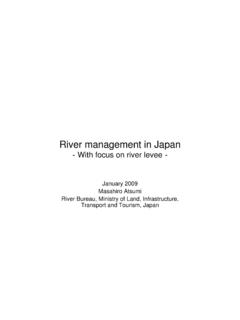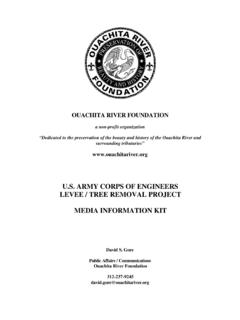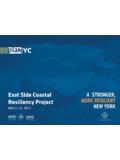Transcription of A Classification of Natural Rivers-Catena Paper
1 Catena 22 (1994) 169-199 CATENA A Classification of Natural rivers David L. Rosgen Wildland Hydrology, 157649 U. S. Highway 160, Pagosa Springs, CO 81147 Abstract A Classification system for Natural rivers is presented in which a morphological arrangement of stream characteristics is organized into relatively homogeneous stream types. This Paper describes morphologically similar stream reaches that are divided into 7 major stream type categories that differ in entrenchment, gradient, width/depth ratio, and sinuosity in various landforms.
2 Within each major category are six additional types delineated by dominate channel materials from bedrock to silt/clay along a continuum of gradient ranges. Recent stream type data used to further define Classification interrelationships were derived from 450 rivers throughout the , Canada, and New Zealand. Data used in the development of this classi-fication involved a great diversity of hydro-physiographic/geomorphic provinces from small to large rivers and in catchments from headwater streams in the mountains to the coastal plains.
3 A stream hierarchical inventory system is presented which utilizes the stream Classification system. Examples for use of this stream Classification system for engineering, fish habitat enhancement, restoration and water resource management applications are presented. Specific examples of these applications include hydraulic geometry relations, sediment supply/availability, fish habitat structure evaluation, flow resistance, critical shear stress estimates, shear stress/velocity relations, streambank erodibility potential, management interpretations, sequences of morpho-logical evolution, and river restoration principles.
4 1. General statement It has long been a goal of individuals working with rivers to define and understand the processes that influence the pattern and character of river systems. The differences in river systems, as well as their similarities under diverse settings, pose a real challenge for study. One axiom associated with rivers is that what initially appears complex is even more so upon further investigation. Underlying these complexities is an assortment of interrelated variables that determines the dimension, pattern, and profile of the present-day river .
5 The resulting physical appearance and character of the river is a product of adjustment of its boundaries to the current streamflow and sediment regime. 0341-8162/94 C 1994 Elsevier Science All rights reserved SSD10341-8162(94)E0046-3 170 Rosgen / Catena 22 (1994) 169-199 river form and fluvial process evolved simultaneously and operate through mutual adjustments toward self-stabilization. Obviously, a Classification scheme risks over-simplification of a very complex system.
6 While this may appear presumptuous, the effort to categorize river systems by channel morphology is justified in order to achieve, to some extent, the following objectives: 1. Predict a river 's behavior from its appearance; 2. Develop specific hydraulic and sediment relations for a given morphological channel type and state; 3. Provide a mechanism to extrapolate site-specific data collected on a given stream reach to those of similar character; 4. Provide a consistent and reproducible frame of reference of communication for those working with river systems in a variety of professional disciplines.
7 2. Stream Classification review A definition of Classification was offered by Platts (1980) where " Classification in the strictest sense means ordering or arranging objects into groups or sets on the basis of their similarities or relationships." The effort to classify streams is not new. Davis (1899) first divided streams into three classes based on relative stage of adjustment: youthful, mature, and old age. Additional river Classification systems based on qua-litative and descriptive delineations were subsequently developed by Melton (1936) and Matthes (1956).
8 Straight, meandering, and braided patterns were described by Leopold and Wolman (1957). Lane (1957) developed quantitative slope-discharge relationships for braided, intermediate, and meandering streams. A Classification based on descriptive and interpretive characteristics was developed by Schumm (1963) where delineation was partly based on channel stability (stable, eroding, or depositing) and mode of sediment transport (mixed load, suspended load, and bedload). A descriptive Classification was also developed by Culbertson et al.
9 (1967) that utilized depositional features, vegetation, braiding patterns, sinuosity, meander scrolls, bank heights, levee formations, and floodplain types. Thornbury (1969) developed a system based on valley types. Patterns were described as antecedent, superposed, consequent, and subsequent. The delineative criteria of these early Classification systems required qualitative geomorphic interpretations creating delineative inconsistencies. Khan (1971) developed a quantitative Classification for sand-bed streams based on sinuosity, slope, and channel pattern.
10 To cover a wider range of stream morphologies, a descriptive Classification scheme was developed for and applied on Canadian Rivers by Kellerhals et al. (1972, 1976), Galay et al. (1973), and Mollard (1973). The work of these Canadian researchers provides excellent description and interpretation of fluvial features. This scheme has utility both for aerial photo delineation and for describing gradual transitions between classical river types. and to date offers the most detailed and complete list of channel and valley features.





